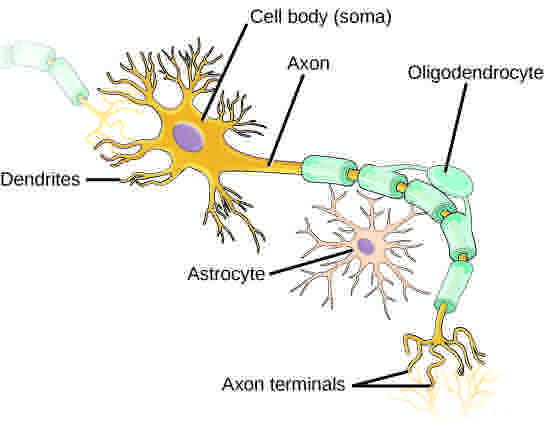Muscle Tissues
There are three types of muscle in animal bodies: smooth, skeletal, and cardiac. They differ by the presence or absence of striations or bands, the number and location of nuclei, whether they are voluntarily or involuntarily controlled, and their location within the body.
Smooth Muscle
Smooth muscle cells have a single, centrally-located nucleus and are spindle shaped. Constriction of smooth muscle occurs under involuntary, autonomic nervous control in response to local conditions in the tissues. Smooth muscle tissue is also called non-striated as it lacks the banded appearance of skeletal and cardiac muscle . The walls of blood vessels, the tubes of the digestive system, and the tubes of the reproductive systems are composed primarily of smooth muscle. Contractions of smooth muscle move food through the digestive tracts and push blood through the blood vessels.

Types of muscle fibers
Smooth muscle cells do not have striations, while skeletal muscle cells do. Cardiac muscle cells have striations, but, unlike the multinucleate skeletal cells, they have only one nucleus. Cardiac muscle tissue also has intercalated discs, specialized regions running along the plasma membrane that join adjacent cardiac muscle cells and assist in passing an electrical impulse from cell to cell.
Skeletal Muscle
Skeletal muscle has striations across its cells caused by the arrangement of the contractile proteins, actin and myosin, that run throughout the muscle fiber . Skeletal muscle cells can contract by the attachment of myosin to actin filaments in the muscle, which then ratchets the actin filaments toward the center of the cells. These muscle cells are relatively long and have multiple nuclei along the edge of the cell. Skeletal muscle is under voluntary, somatic nervous system control and is found in the muscles that move bones. Stimulation of these cells by somatic motor neurons signals the cells to contract.
Cardiac Muscle
Cardiac muscle is found only in the heart. Similar to skeletal muscle, it has cross striations in its cells, but cardiac muscle has a single, centrally-located nucleus; the muscle branches in many directions . Cardiac muscle is not under voluntary control, but is influenced by the autonomic nervous system to speed up or slow down the heart beat. An added feature to cardiac muscle cells is a line that extends along the end of the cell as it abuts the next cardiac cell in the row. This line, an intercalated disc, assists in passing electrical impulses efficiently from one cell to the next while maintaining the strong connection between neighboring cardiac cells, allowing the cardiac muscle cells to synchronize the beating of the heart.
Nervous Tissues
Nervous tissues are made of cells specialized to receive and transmit electrical impulses from specific areas of the body and to send them to specific locations in the body organized into structures called nerves. A nerve consists of a neuron and glial cells. The main cell of the nervous system is the neuron. There is a large structure with a central nucleus: the cell body (or soma) of the neuron. Projections from the cell body are either dendrites, specialized in receiving input, or a single axon, specialized in transmitting impulses . Glial cells support the neurons. Astrocytes regulate the chemical environment of the nerve cell, while oligodendrocytes insulate the axon so the electrical nerve impulse is transferred more efficiently. Other glial cells support the nutritional and waste requirements of the neuron. Some of the glial cells are phagocytic, removing debris or damaged cells from the tissue.

Neuron
The neuron has projections called dendrites that receive signals and projections called axons that send signals. Also shown are two types of glial cells: astrocytes to regulate the chemical environment of the nerve cell, and oligodendrocytes to insulate the axon so the electrical nerve impulse is transferred more efficiently.